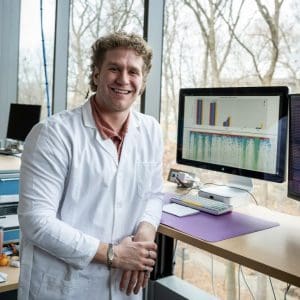Overview:
Lance studies intra- and inter-species genetic variation in self-fertilizing (selfing) Caenorhabditis species. He is a PhD candidate in Erik Andersen’s laboratory. Genetic diversity in a population aids organismal survival in heterogeneous environments. We see it all around us, whether it is bacterial antibiotic resistance, the finch with ‘just the right sized’ beak to take advantage of more food sources, or your friend who has no issues ascending Mount Everest thanks to their genetic adaptations that improves the efficiency of oxygen use. Much of this genetic diversity is due to sexual reproduction and exchange of alleles in a population. The reproductive mode of selfing leads to a decrease in heterozygosity and alleles in the gene pool, which limits adaptation to heterogeneous environments. In the genus Caenorhabditis, the reproductive mode of selfing has evolved independently at least three times, and these selfing species are able to survive in the same ecological niches as non-selfing (outcrossing) Caenorhabditis species. Lance uses bioinformatics methods to analyze whole-genome and RNA sequencing data with the goal of unraveling the intricacies of how these selfing species create and maintain genetic variation in a population in order to survive in heterogeneous environments.
Specific research:
The Andersen lab has amassed a collection of thousands of selfing Caenorhabditis strains from all across the world. These strains have been cryopreserved and whole-genome sequenced using DNA sequencing methods (Illumina short-read and Pacific Bioscience long-read). The investigation of the patterns of genomic diversity amongst all wild strains has revealed punctuated regions of extreme variation, referred to as hyper-divergent regions (HDRs). These HDRs are pervasive in selfing Caenorhabditis species, where they span ~20% of the C. elegans reference genome. HDRs are not unique to the Caenorhabditis genus and are found in the genomes across the tree of life such as plants and humans. During his time in the Andersen lab, Lance aims to refine comparative genomics methods to call HDRs, perform de novo genome assemblies of hundreds of selfing Caenorhabditis strains, and further characterize the genomic content in HDRs using gene model curation with RNA-sequencing data. His goal is to elucidate the functional roles these HDRs have in selfing Caenorhabditis species’ ability to survive in heterogeneous environments, as well as their origin and maintenance throughout evolution.
“It is hard to pick my favorite part about the Andersen laboratory, but I definitely know that I am in the right lab. My PI always has his door open; he is always open to hearing a joke even if we are stressed out, and he fosters an environment where everybody’s opinions and questions have the same value whether you are an undergraduate, graduate student, or post-doc. Everybody knows each other’s project inside and out, so I can go to essentially anybody in the lab for advice or troubleshooting. You never feel like you are struggling alone no matter the issue.”
Path and career trajectory:
Lance came to CMDB with no background in genomics or genetics. Hailing from Minnesota, Lance attended the University of Minnesota where he completed a bachelor’s degree in Cellular and Organismal Physiology. Beginning undergraduate training, he was unsure about his career trajectory and what he ultimately wanted to do but knew that he enjoyed understanding how things work. This curiosity led him to pursue a pre-med track with hopes of becoming a physician. He quickly learned that he was much more interested in the molecular mechanisms of disease pathogenesis than disease treatment.
Lance first got involved in biological research during his sophomore year, where he continued to seek research positions in different biological disciplines to expose himself to the breadth of biological research as best he could. He gained research experience in computational transcriptomics, developmental neuroscience, and cell biology/biophysics. When applying to graduate programs, Lance knew he wanted to join a rotational program as he felt that there were more research disciplines to be explored. He ultimately joined CMDB because, “At no other university have I experienced such a “family dynamic” than in the Department of Biology at Hopkins. All the faculty and students joke with one another, and they all know each other on a personal level and not just what they research. The expertise and collaborations at Hopkins are unbelievable, I truly feel like everybody here wants each other to succeed.”
Advice and opinions:
Lance states, “I have found that in graduate school, at least at Johns Hopkins, it is encouraged to have hobbies outside of your research. Many faculty and students have strong passions outside of their research and work-life balance is valued highly here.” Something that Hopkins CMDB has taught Lance is to be open-minded to all disciplines of research and absorb as much knowledge as possible. He has found that with the broad range of research being performed at Hopkins, he states that “you never know when a piece of information or assay will be helpful in your own personal research endeavors.” He advises incoming students to take full advantage of Baltimore’s rich diversity and liveliness. Since moving to Baltimore, he has joined athletic clubs and attended entertainment events where he says it has been easy and fun to meet people from all walks of life. Lance often visits DC because it is a quick commute away, where he says, “Baltimore and DC are great places to live when starting your career as both cities are filled with people in the same position, making it easy to network and make friends.”
